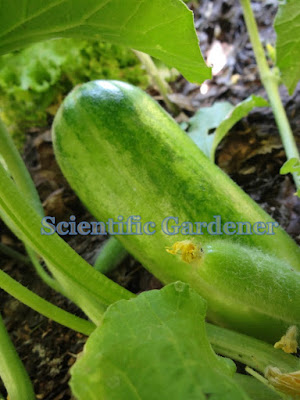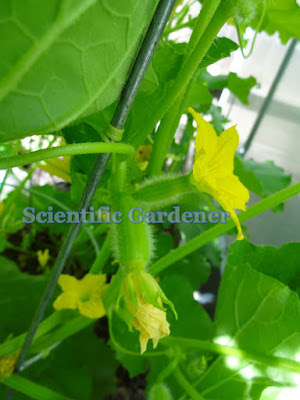Life is full of both chances and opportunities. Every chance or opportunity comes with possible risks and rewards. Over the years, I have taken my chances with many varieties of cucumber-melon. Some, like the Carosello Massafrese, have been beautiful, productive and delicious. Others, such as the Tursuluk Kelek, have had many qualities to be improved upon.
So, how do I make sure that I am getting something good? Most of what I do is research as much as possible. Where does the desirable variety come from, what are the desirable traits, does the seller have references, do they have pictures that they have taken of the variety? Based on answers to this, along with some other factors, I decided to take my chances and grow out a variety that I had not planned on growing out in my home garden this spring.
I started the season off by growing out transplants in the greenhouse. I had grown fava beans this last winter, which left a very good store of nitrogen-fixing leguminous nodules in the ground for the young transplants to establish their roots on. Additionally, I spread out a fine leaf and manure – based compost and spread a partially composted leaf mulch around the transplants.
Not only did I check before growing out the Striped Leccese, but I repeatedly did as much as I could, throughout the season, to ensure that I was investing in the right kind of cucumber. One thing I look for in a good Carosello variety is oval or round female fruit. Juicy fruit often begins with oval or round female flowers, so oval female flower ovary stems are a very positive indicator.
Every spring I have the opportunity to hand-pollinate female flowers before the bees arrive. As the climate changes and as other factors (such as increased hive pressures from pervasive pesticides) bees may become more scarce. The day in May or June in which the bees arrive also changes from year to year. Without consistent bee pollination, it is important to know how to successfully hand-pollinate my flowers.
As it took a while for the female fruit to develop stripes, I decided to try some of the fruit out. It was very tender, juicy and delicious. The lack of stripes began concerning me so much that I contacted the seller, who assured me that the fruit would end up developing dark bands.
Though the color remained the same for all of the fruit, the length varied – depending on what vine it came from. Some vines produced little shorter fruit while others produced larger longer fruit. At first I was concerned about the variation and then I remembered that variation can be a very good thing – as long as there are only a few things in flux.
Around the same time as the bees began pollinating my Carosello flowers, the fruit began to develop stripes. Soon stripes began appearing on more and more fruit. Though I knew I had something good, I had no idea how good what I had was until the season progressed.
 |
| The Striped Carosello Leccese |
So, how do I make sure that I am getting something good? Most of what I do is research as much as possible. Where does the desirable variety come from, what are the desirable traits, does the seller have references, do they have pictures that they have taken of the variety? Based on answers to this, along with some other factors, I decided to take my chances and grow out a variety that I had not planned on growing out in my home garden this spring.
 |
| Putting out transplants, April 25th, 2019 |
I started the season off by growing out transplants in the greenhouse. I had grown fava beans this last winter, which left a very good store of nitrogen-fixing leguminous nodules in the ground for the young transplants to establish their roots on. Additionally, I spread out a fine leaf and manure – based compost and spread a partially composted leaf mulch around the transplants.
 |
| Mulching with partially composted leaves, April 27th |
 |
| Plastic Collars as a barrier to cutworms, April 30th |
 |
| May 20th |
 |
| May 22nd |
 |
| May 28th |
 |
| June 1st |
 |
| First female flower set, June 5th |
 |
| June 6th |
 |
| June 7th |
 |
| June 11th |
Not only did I check before growing out the Striped Leccese, but I repeatedly did as much as I could, throughout the season, to ensure that I was investing in the right kind of cucumber. One thing I look for in a good Carosello variety is oval or round female fruit. Juicy fruit often begins with oval or round female flowers, so oval female flower ovary stems are a very positive indicator.
 |
| Long oval female flower of the Striped Carosello Leccese |
 |
| June 12th |
 |
| June 14th |
 |
| A baby tendril |
 |
| Baby tendril closeup |
 |
| June 15th |
 |
| June 17th |
 |
| June 18th |
 |
| June 18th, Bees finally discover the garden |
Every spring I have the opportunity to hand-pollinate female flowers before the bees arrive. As the climate changes and as other factors (such as increased hive pressures from pervasive pesticides) bees may become more scarce. The day in May or June in which the bees arrive also changes from year to year. Without consistent bee pollination, it is important to know how to successfully hand-pollinate my flowers.
 |
| June 19th |
 |
| June 20th, Lots of female flower setting |
 |
| All female flowers |
As it took a while for the female fruit to develop stripes, I decided to try some of the fruit out. It was very tender, juicy and delicious. The lack of stripes began concerning me so much that I contacted the seller, who assured me that the fruit would end up developing dark bands.
Though the color remained the same for all of the fruit, the length varied – depending on what vine it came from. Some vines produced little shorter fruit while others produced larger longer fruit. At first I was concerned about the variation and then I remembered that variation can be a very good thing – as long as there are only a few things in flux.
 |
| June 21st |
 |
| June 22nd |
Around the same time as the bees began pollinating my Carosello flowers, the fruit began to develop stripes. Soon stripes began appearing on more and more fruit. Though I knew I had something good, I had no idea how good what I had was until the season progressed.







































































































No comments:
Post a Comment
Dear Gardening Friends,
I look forward to learning more about gardening with you. Your comments help me recognize that gardening is a life-long journey.
To advertisers: Note that this blog is concerned with gardening and gardening techniques. Please do not attempt to advertise here by leaving a comment. Depending upon how egregious the comment is, it may be deleted.